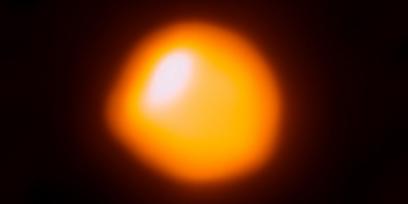
Irish astronomer Dr Eamon O’Gorman leads international team to make stellar discovery
Posted: 27 June, 2017

Irish Research Council funded astronomer at the Dublin Institute for Advanced Studies, Dr Eamon O’Gorman, led an international team of astronomers to make the most detailed image of the surface of a star (other than the sun) that has ever been created at radio wavelengths. The image was made using ALMA (Atacama Large Millimeter/submillimetre Array), the world’s largest radio telescope.
The image was taken of Betelgeuse, the famous Red Supergiant located in the constellation Orion, and resulted in the discovery that the temperature in its inner atmosphere is not uniform. This could help explain how the atmosphere of these stars are heated, and how material from these stars is transported to the interstellar medium.
Commenting on the discovery, Dr Eamon O’Gorman said: “ALMA now provides us with the capabilities to image surface features on nearby stars while also directly measuring the temperature of these features. We have known for decades that the visible surface of Betelgeuse is not uniform, but ALMA has now shown us in detail that the temperature in its inner atmosphere is also not uniform. It looks like these temperature fluctuations could be caused by magnetic fields, similar to what we see on the Sun, our nearest star.”
Also commenting on the image was Dr Pierre Kervella, astronomer at the Paris Observatory and member of the team, “Located about 650 light years away, Betelgeuse is certainly not the closest star to our solar system, but its sheer size makes it an ideal target to image directly with ALMA. When we look at the night sky with our naked eyes, we see bright stars everywhere, but because they are so small, even the most powerful telescopes in the world struggle to image their surfaces. Our results show ALMA has the capability to image the surfaces of the largest stars in detail.”
In terms of size, Betelgeuse is approximately 1400 times larger than our Sun, and more than one billion times larger in terms of volume. As stars like Betelgeuse evolve, they expel an enormous amount of themselves back into the interstellar medium via stellar winds. These winds contain crucial heavy elements that the stars have manufactured and are vital ingredients for the next generation of stars and planets.
The team’s results have recently been published in the journal ‘Astronomy & Astrophysics’ and was featured today in the Irish Times. Photo credit: ESO/E. O’Gorman.

